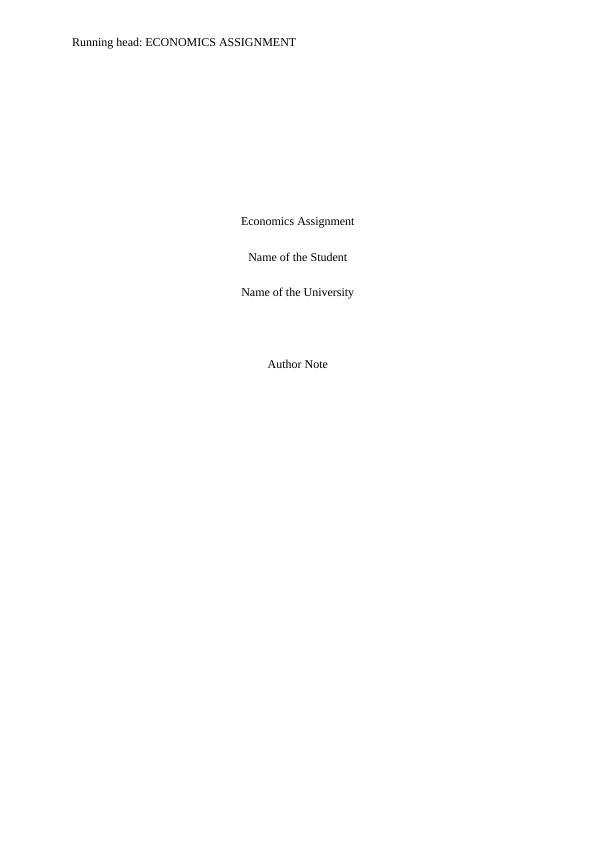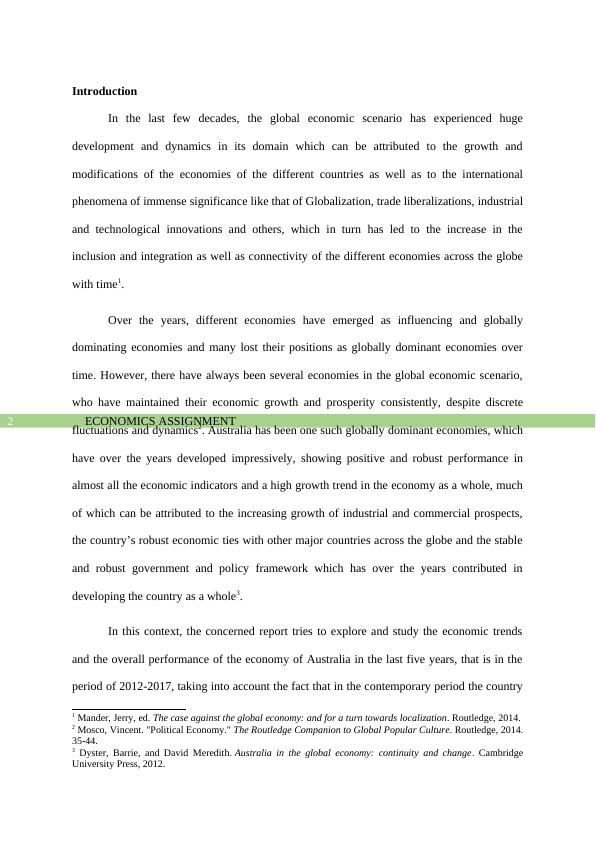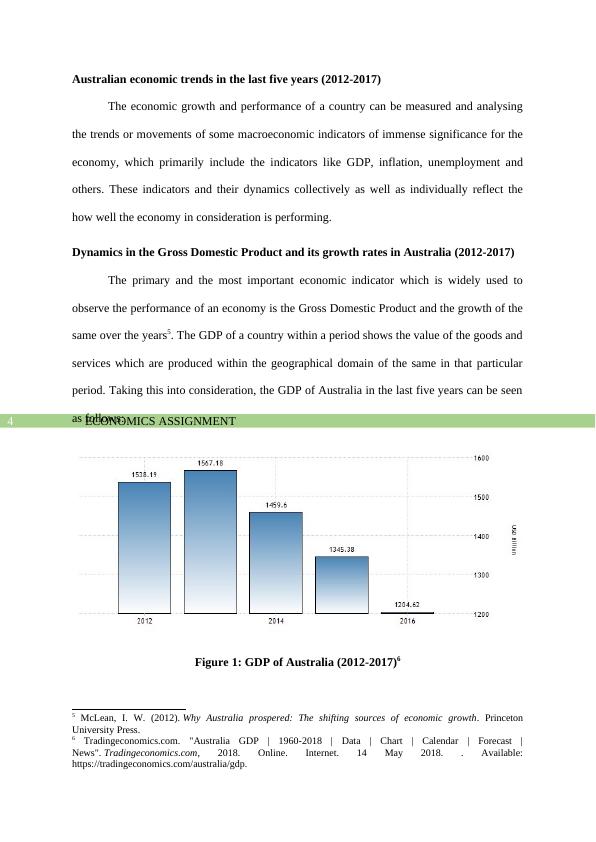(PDF) Economics Assignment Solution
21 Pages3736 Words31 Views
Added on 2021-06-16
(PDF) Economics Assignment Solution
Added on 2021-06-16
ShareRelated Documents
Running head: ECONOMICS ASSIGNMENT Economics AssignmentName of the StudentName of the UniversityAuthor Note

ECONOMICS ASSIGNMENT 1Table of ContentsIntroduction................................................................................................................................2Australia: Economic Overview..................................................................................................3Australian economic trends in the last five years (2012-2017)..................................................4Dynamics in the Gross Domestic Product and its growth rates in Australia (2012-2017)....4Rate of Inflation in Australia over the last five years............................................................7Unemployment Rate in the last five years.............................................................................9Consumption expenditure....................................................................................................10Economic Interpretation.......................................................................................................11Policy Framework....................................................................................................................11Industrial Growth (2012-2017)................................................................................................14Reasons for service sector growth........................................................................................15Conclusion................................................................................................................................16References................................................................................................................................18

ECONOMICS ASSIGNMENT 2Introduction In the last few decades, the global economic scenario has experienced hugedevelopment and dynamics in its domain which can be attributed to the growth andmodifications of the economies of the different countries as well as to the internationalphenomena of immense significance like that of Globalization, trade liberalizations, industrialand technological innovations and others, which in turn has led to the increase in theinclusion and integration as well as connectivity of the different economies across the globewith time1. Over the years, different economies have emerged as influencing and globallydominating economies and many lost their positions as globally dominant economies overtime. However, there have always been several economies in the global economic scenario,who have maintained their economic growth and prosperity consistently, despite discretefluctuations and dynamics2. Australia has been one such globally dominant economies, whichhave over the years developed impressively, showing positive and robust performance inalmost all the economic indicators and a high growth trend in the economy as a whole, muchof which can be attributed to the increasing growth of industrial and commercial prospects,the country’s robust economic ties with other major countries across the globe and the stableand robust government and policy framework which has over the years contributed indeveloping the country as a whole3. In this context, the concerned report tries to explore and study the economic trendsand the overall performance of the economy of Australia in the last five years, that is in theperiod of 2012-2017, taking into account the fact that in the contemporary period the country1 Mander, Jerry, ed.The case against the global economy: and for a turn towards localization. Routledge, 2014.2 Mosco, Vincent. "Political Economy."The Routledge Companion to Global Popular Culture. Routledge, 2014.35-44.3 Dyster, Barrie, and David Meredith.Australia in the global economy: continuity and change. CambridgeUniversity Press, 2012.

ECONOMICS ASSIGNMENT 3has experienced considerable fluctuations in the economic domain due to both endogenousactivities as well as exogenous factors happening outside the economy itself but havingconsiderable impacts on the economy. The report tries to observe the dynamics in the majormacroeconomic parameters in the country during the concerned period and also tries toanalyse the policy framework present in the country in this respect. Apart from that the reportdiscusses the industrial shifts and industries which have been growing in the contemporaryperiod, thereby exploring the reasons behind the growth of the same. Australia: Economic Overview As discussed above, the economy of Australia is an example of a highly developedand visibly stable and probably the largest mixed economy in the global scenario. Thecountry, ranking fourth globally in terms of Nominal GDP and second in terms of totalwealth of the adult population, is known for its gradual growth and visible stability which inturn have contributed to the industrial development and the economic prosperity of thecountry4. The country has enjoyed the status of a mining and technological giant in the globalframework for decades and has developed huge multi-lateral and prosperous long-term tradeand commerce relationships with all parts of the globe which has also contributed to theincreasing development of the economy. Keeping this into consideration, the following section of the report tries to analyse andinterpret the dynamics which the economy of the country has been experiencing in the lastfive years, by observing the trends in the performance of the major economic indicators of thecountry. 4 Groenewegen, Peter, and Bruce McFarlane.A History of Australian Economic Thought (Routledge Revivals).Routledge, 2014.

ECONOMICS ASSIGNMENT 4Australian economic trends in the last five years (2012-2017) The economic growth and performance of a country can be measured and analysingthe trends or movements of some macroeconomic indicators of immense significance for theeconomy, which primarily include the indicators like GDP, inflation, unemployment andothers. These indicators and their dynamics collectively as well as individually reflect thehow well the economy in consideration is performing. Dynamics in the Gross Domestic Product and its growth rates in Australia (2012-2017) The primary and the most important economic indicator which is widely used toobserve the performance of an economy is the Gross Domestic Product and the growth of thesame over the years5. The GDP of a country within a period shows the value of the goods andservices which are produced within the geographical domain of the same in that particularperiod. Taking this into consideration, the GDP of Australia in the last five years can be seenas follows: Figure 1: GDP of Australia (2012-2017)65 McLean, I. W. (2012).Why Australia prospered: The shifting sources of economic growth. PrincetonUniversity Press.6 Tradingeconomics.com. "Australia GDP | 1960-2018 | Data | Chart | Calendar | Forecast |News".Tradingeconomics.com, 2018. Online. Internet. 14 May 2018. . Available:https://tradingeconomics.com/australia/gdp.

ECONOMICS ASSIGNMENT 5In spite of the considerable stability in the economic growth of the country over theyears, in the last few years, the GDP of the country is surprisingly found to be decreasinggradually. In the last five years, the GDP of the country decreased from 1538 billion toalmost 1204 billion which is quite unusual for the country, given the fact that the country hadbeen prospering considerably and stably over the decades. To understand the dynamics in theGDP statistics of the country, the growth rate of the same in the period of concern is seen asfollows: Figure 2: GDP Growth Rate of Australia (2012-2017)7From the above figure, it is evident that the growth rate of the GDP of Australia hasbeen subjected to considerable fluctuations in the last five years. However, these fluctuationshave been positive as well as negative, with one major trough in late 2016. The economyhowever recovered from the visible dip abruptly by the beginning of 2017. However, thegrowth rate trends of the GDP in the country in the last five years did not show any visiblepositive trend, which is also augmented by the observation of falling GDP the country in theperiod under consideration8. 7 Tradingeconomics.com. "Australia GDP Growth Rate | 1959-2018 | Data | Chart | Calendar |Forecast".Tradingeconomics.com, 2018. Online. Internet. 14 May 2018. . Available:https://tradingeconomics.com/australia/gdp-growth.8 Butlin, Noel George.Investment in Australian economic development, 1861-1900. Cambridge UniversityPress, 2013.

End of preview
Want to access all the pages? Upload your documents or become a member.
Related Documents
Economic Growth and Policy Framework of Australia (2012-2017)lg...
|22
|4241
|145
Assignment on Economics (PDF)lg...
|18
|3854
|20
Economy of Australia: GDP, Inflation, Unemployment, Trade Volumes and Policy Structurelg...
|18
|3856
|168
Macroeconomic Analysis of Australia: Real GDP, Inflation, Unemployment, Business Cycle, Net Exports and Exchange Rateslg...
|12
|4372
|275
Economy of Australia - Assignmentlg...
|18
|3584
|41
The Economy of Australia | Assignmentlg...
|14
|3945
|68
